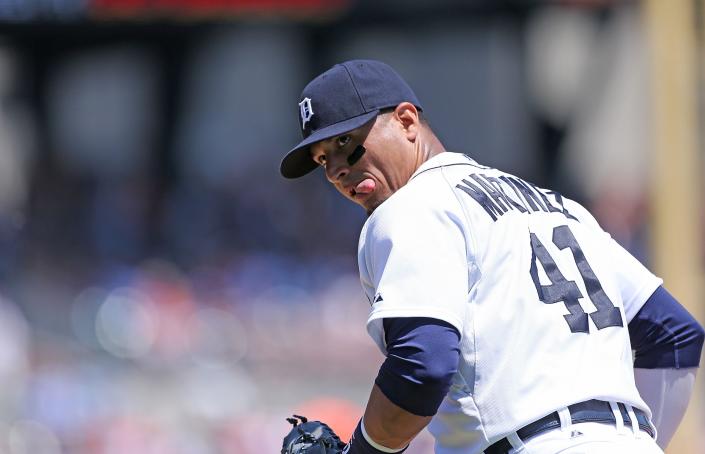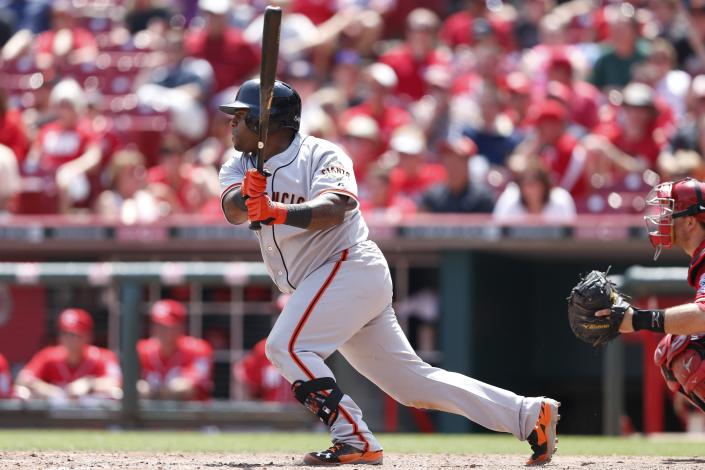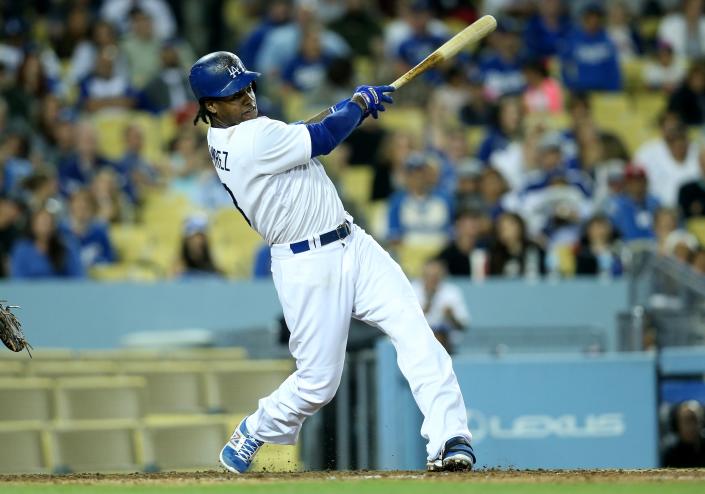10 Degrees: Looking ahead to the 2015 free-agent class
Now that the last of 2014's free agents signed, here is a summary of the Class of 2015: three $100 million pitchers, slumping star, thumping question mark, old guy, disappointment and a mish-mash of 175 or so others.
Baseball can be divided into four different seasons: the regular season, its six-week-or-so sliver subjugated by the trade deadline, the postseason and the one that speaks as much to our modern sports consumption as anything baseball offers, the offseason. It is a parade of speculation and rumors and scenario-dreaming and gossip, tailor-made for Twitter, commodified by MLBTradeRumors.com, devoured by a public ravenous for more.
And so it's never too early to consider impending free agency, seeing as these first two months do wonders in shaping the profile of each particular player headed there. The fast starters can market themselves on the arbitrary endpoints of their fast starts, and teams can relish the slow starters because they may represent bargains, and the rest can aim for the next four months to look more the former than the latter.
Among the glitterati of the group, there was one unaccounted-for epithet above: the powerful enigma. He is not the best player in the class. He might be the most interesting, considering where he's been, what he's doing and how exactly the industry will view him come November. Because nobody will forget how ...
1. Nelson Cruz sat as a free agent, ripe to be picked, for nearly four months. As far as multimillionaire problems go, it got sort of sad. He turned down $14 million, which seemed like the right move until the market for good players with draft-pick compensation attached completely collapsed around him.
It didn't matter that before his Biogenesis suspension, Cruz was on pace to hit 40-plus home runs, a rare feat in today's power-starved environment. There were the drug ties and the bad glove and the 1980 birthday and draft-bonus money, and as happens with free agency, once a narrative attaches itself to a player, the 30 teams huddle together and shy away. It's fear perpetuated by pack mentality. One could argue it's collusive.
Never has Orioles general manager Dan Duquette feared being different, and so he plucked Cruz out of the bargain bin for $8 million and the cost of the 55th pick in last week's draft. And maybe whomever they chose would have developed into a star. Nobody will know.
What the Orioles do know is this: They'd be dead in the water without Cruz's major league-leading 21 home runs and 55 RBIs. And because they signed him before the season began, they get to tender him the same qualifying offer the Rangers did after last season, and that draft pick they gave up will be returned a year later, meaning the net cost of a likely 40-homer season will be $8 million and a one-year delay on a choice in the first round instead of the second. That's not a win. It's a triumph.
Cruz's inclusion among the top three hitters in the impending class isn't just striking because of his ascent. It's a testament to the group's weakness that he and ...

2. Victor Martinez share the position of designated hitter that takes away so much value. Far lesser hitters have far more real-world worth, and yet big bats remain such a rare commodity that the market for Cruz and Martinez could well run wild this offseason.
If Cruz is the Boomstick, Martinez should be the Pixie Stick, with a swing as sweet and refined as sugar. He controls the plate like no hitter in baseball. At 35 years old, he somehow has grown into an amalgamation of prime-era Ichiro Suzuki and Albert Pujols, dangerous from both sides of the plate, powerful yet in complete control. He is Edgar Martinez without the walks, and anyone who played during Edgar's era agrees that even a conditional comparison is about the best compliment one can pay a hitter.
Surely Detroit will attach a qualifying offer to Martinez. A year at the $15 million or so it will pay is a bargain – remember, there's no such thing as a bad one-year contract – and the market should reward Martinez with a multiyear deal, even if he's limited to American League teams. Even if Martinez sticks around, chances are they'll end up with an extra pick on account of ...
3. Max Scherzer finding a new team. And considering the Tigers offered him $144 million before the season and he turned it down, that possibility looms ever greater, even if he isn't quite duplicating his 2013 Cy Young season.
Still, Scherzer presents an interesting case for whichever team tries to sign him. Even as industry revenues blow past $9 billion, the nine-figure player remains a rare breed, scrutinized to the end. A $100 million pitcher is even sketchier, what with elbows dissolving like cotton candy, and to give at least $150 million, and maybe closer to $200 million, to a pitcher with a 3.38 ERA simply doesn't register.
And no matter how wrongheaded that thinking may be – Scherzer's strikeout, walk and home run rates are almost identical to last season, only his luck on balls in play has flipped 70 batting-average points in the wrong direction – it's the sort of question $100 million players face. The price of riches is scrutiny, and no matter where he goes, Scherzer understands it chases him. It makes staying where you've succeeded appealing, divesting yourself of at least one potential bad variable, and it's why ...
4. Jon Lester came out and publicly said he wanted to remain with Boston. The Red Sox took that show of good will, gave him an all-time lowball offer – four years and $70 million, half of Scherzer's offer despite Lester winning two World Series rings and owning the exact 117 career ERA+ as Scherzer – and now he's headed to free agency, where the market can determine what he's worth.
Lester, actually, is in the very same place as Scherzer this season: a rough BABIP that makes his ERA look worse than his peripherals say it should. Their numbers are practically identical:
| ERA | GS | IP | H/9 | BB/9 | K/9 | HR/9 | BABIP | W-L |
Lester | 3.52 | 13 | 84.1 | 9.1 | 2.5 | 10.1 | 0.9 | .347 | 6-7 |
Scherzer | 3.38 | 13 | 85.1 | 8.5 | 2.6 | 10.3 | 0.9 | .330 | 7-2 |
They've separated themselves from James Shields, who still should get nine figures because of his durability, quality stuff that hasn't degraded and the perception that he's a legitimate staff leader. Which differs from ...
5. Ervin Santana even though the former teammates' numbers this year are awfully similar.
| ERA | GS | IP | H/9 | BB/9 | K/9 | HR/9 | BABIP | W-L |
Shields | 3.44 | 14 | 91.2 | 9.2 | 2.1 | 7.7 | 1.2 | .312 | 7-3 |
Santana | 3.69 | 11 | 70.2 | 8.7 | 2.7 | 7.5 | 0.6 | .317 | 5-2 |
Chances are Shields' home run rate will flatten and Santana's climb, which would put a little more distance in their ERAs, but the chasm in the general consensus on the two is staggering considering Santana had to settle for a one-year, $14 million deal and now will head back into free agency saddled with a qualifying offer and the stigma of having wallowed in the free agent pool for months like Cruz.
Atlanta rescued him this year and is elated for having done so. Like Baltimore, it played the free-agent game perfectly. Santana knows this time that a $100 million demand won't cut it, even if that's what Shields and Scherzer and Lester are getting. He knows the feeling of being the fruit nobody wants to pick, even if it's plenty good. It's why ...
6. Kendrys Morales and Stephen Drew sat around for six months without a team. At some point mid-winter, teams settled on the idea that Morales and Drew (and Cruz and Santana, too) could be had for a bargain. Teams refused to budge off this idea, and the players, each having turned down $14.1 million, had zero leverage.
Cruz chose to eat $6 million, play a full season and earn his future earnings. Santana settled for even money and figured he, too, could convince teams he was worth a multiyear deal. Morales and Drew, both advised by Scott Boras, played the waiting game, both cognizant that waiting until after opening day to sign meant no qualifying-offer morass next season.
At the same time, both gave away two months of building up numbers and millions of dollars. And while it's easy to say both are losers for choosing this particular path, the ultimate arbiter will be their next contracts. If they do get guaranteed money over the long haul – if they're deemed better choices at their positions than, say, Adam Dunn or Asdrubal Cabrera – perhaps then they can rest easy with their choices. Especially if their qualifying-offer brethren once again run into trouble.
The expectation after the stalemate this year was that someone would accept the offer come this offseason rather than chance it. Take ...

7. Pablo Sandoval for example. He'll hit free agency at 28. In theory, that's great. And he has proven himself a remarkable hitter at times. Which tantalizes every team that so desperately covets a bat.
Only the concern over Sandoval's weight, forever yo-yoing, balances whatever advantage his age provides. And minus a few moments of pop, his bat turned flaccid this season. It could very well be bad luck – his .258 BABIP is about 50 points below his career average, the same spread between his career batting average and the .245 he's sporting – but such misfortune is seen only by ballclubs as an opportunity to take advantage of a player that's down.
The Giants almost assuredly will give Sandoval a qualifying offer. It makes sense. And it make sense, too, for him to accept it. Not only is a salary of around $15 million great, if Sandoval bounces back with a big season, he'll still go into free agency again before his 30th birthday with a chance to truly cash in. Rejecting the qualifying offer would put him in an awful position: trying to convince a team to pay him like a star when the last sign of that was in the 2012 World Series.
He's not San Francisco's only difficult qualifying-offer choice, seeing as ...
8. Michael Morse has stayed healthy and done what a healthy Morse does, which is rake. His 13 home runs this year match last season's total and his 42 RBIs are 50 percent higher, in 83 fewer plate appearances. He's slugging better than he did in the 2011 season that earned him down-ballot MVP votes, and while his plate discipline remains dreadful, Morse has remade his reputation as much as any free agent to be.
Here are 15 others whose 2014s have helped and hurt.
HELP
Kurt Suzuki, C: Never strikes out. Gets on base. Helped tame a difficult-to-manage Twins pitching staff. Worthy of everyday at-bats.
Seth Smith, OF: Destroys right-handed pitching. In the platoon era, a truly valuable commodity.
Gavin Floyd, SP: Back from Tommy John and throwing more strikes than he ever has. The 65 percent first-pitch strikes are tremendous.
Ryan Vogelsong, SP: Rediscovered at least 1 mph of velocity from a mess of 2013 and, even at 37, should get at least another year.
Melky Cabrera, OF: Cooled down some but still hitting the ball often and with authority. Someone will give him multiple years.
Koji Uehara, RP: Amazing. Fastball doesn't crack 90 and nobody can hit him. Like Trevor Hoffman 2.0, with the splitter standing in for the changeup.
Luke Gregerson, RP: Career-low walk rate. Slider still a monster. Only question is health with all the breaking balls, but elbow has held up just fine.
HURT
Colby Rasmus, OF: He's injured, and before that he sported a 47-to-7 K-to-BB rate. Even if he's young and has pop, that's a non-starter.
Nori Aoki, OF: Low on-base percentage, no pop, mediocre in the outfield. Looks like a fourth outfielder right now.
Michael Cuddyer, OF: Always about health, and it's a bad look at 35 to go down with a hamstring and follow it up with a sore shoulder.
A.J. Burnett, SP: Issued the most walks in baseball and will turn 38 before next season.
Francisco Liriano, SP: Bad Frankie always shows up before free agency.
J.J. Hardy, SS: Hitting .300, which is nice. Still hasn't homered, which is almost inconceivable for someone who has hit 77 over the last three seasons. Drought is losing him a lot of money.
Justin Masterson, SP: Fastball still sitting below 90 mph. Will be lucky to get the $51 million Cleveland offered during spring training.
Chase Headley, 3B: Now below the Mendoza Line. And to think, two years ago, it looked like he'd be the headliner of this class, above even ...

9. Hanley Ramirez, whose first half-season with the Dodgers was just OK. Then came last year, when he turned in an MVP-caliber performance over half a season, outshining even Yasiel Puig. Ramirez is back to his final-years-in-Miami self, and he joins Cruz and Martinez atop the class based more on potential than production.
Yes, he's an infielder, and that adds value to his bat. And yet no team in its right mind will install Ramirez as its shortstop long-term. He's a third baseman masquerading in shortstop clothes, and the sooner he moves to the position better suited to his body, the better off he and his next team, whether it's in Los Angeles or elsewhere, will be.
Ramirez's place near the head of the group speaks as much to the group's lack of depth as it does his prowess. Wild cards do exist in the form of club options that could give the class some added depth. Baltimore almost surely will let go of Nick Markakis ($17.5 million option with a $2 million buyout) and Washington could do the same with Adam LaRoche ($15 million mutual option with a $2 million buyout). Other potential free agents include Chad Billingsley ($14M/$3M), Yovani Gallardo ($13M/$600K), Billy Butler ($12.5M/$1M), Brett Anderson ($12M/$1.5M), Brandon Morrow ($10M/$1M) and Denard Span ($9M/$500K). Each would play second fiddle to ...
10. Nelson Cruz trying to make up for last offseason. Even with the steroid specter, the fielding issues and the 34 years of age, Cruz should have no problem getting paid, not with home runs at their lowest level (0.92 per game) since 1993. The struggle for offense around baseball is absurd, and even if Cruz slumps to below a 1.000 OPS, he'll still be far, far ahead of the .709 average around the game. Cruz's slugging percentage of .645 is almost higher by itself.
And whether it's the Kansas City Royals (who as a team are outhomering Cruz by just seven) or the feckless New York Mets (whose .349 slugging percentage, and lineup, actually gets a boost from a geriatric Bobby Abreu) or any other team on the cusp of the top 10 picks in the draft, which are protected from signing free agents, the decision won't be easy. It's what makes Cruz's conundrum all the more confusing.
The choice to sign him shouldn't be difficult for any team. It will be for plenty. Which is how Cruz is likely to end up in a bigger market, with a team that can afford to pay its way around a draft pick lost. Some players are worth forfeiting that choice. Should he continue on, this incarnation of Nelson Cruz – this monster in a game that no longer breeds them – will be one such player.

